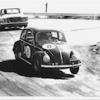
After Doug Ogden found this neat colorized photo of a Peugeot, it prompted us to put together a detailed post on The Old Motor about these fine cars. Below is one page of four from a detailed article in The Automobile dated Sept. 26, 1912. Below that is the first of two pages from The Automobile dated Feb. 12, 1914, telling and showing the updates made to the car and the engines. All can be seen on The Old Motor along with a neat film of the race.
























